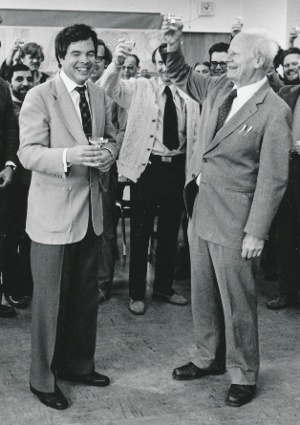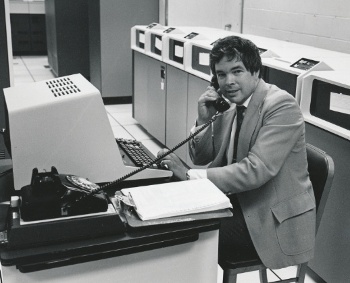Kenneth G. Wilson
June 21, 2013
Wilson is a common
English surname. It's a
patronymic form, meaning the "son of Will," and Will was historically a very common English name. In that sense, it's the same as the
Russian "-ovich," and the
Hebrew "bar-." Wilson is the seventh most common surname in the
United Kingdom, and it's the eighth most common surname in the
United States.
Although the name, Wilson, is common,
physics has been graced by many uncommon
physicists having the name Wilson. Here are a few of the most prominent, arranged
chronologically by birth date.
•
Charles Thomson Rees Wilson (1869-1959) received the 1927
Nobel Prize in Physics for the
invention of the
cloud chamber at
Cambridge University. One of his
academic mentors was
J. J. Thomson, winner of the 1906 Nobel Prize in Physics for his discovery of the
electron.
•
William Wilson (1887-1948) worked with
Rutherford on
radioactivity, and he joined
Bell Labs in 1915 to work on
radiotelephone systems. He was awarded the
IEEE Medal of Honor in 1943 for his radiotelephone research.
•
Alan Herries Wilson (1906-1995) was a
mathematical physicist who studied
quantum mechanics under
R.H. Fowler and
Werner Heisenberg. In physics, he is best known for formulating the
energy band theory of
electrical conductance. Elsewhere, he is known as
chairman of the
pharmaceutical company,
Glaxo, from 1963 until retirement in 1973. Physicists are very capable managers, as many government and industrial organizations have found.
•
Olin Chaddock Wilson (1909-1994) was an American
astronomer who worked on
stellar spectroscopy. He discovered
stellar activity cycles, the stellar equivalent of our
Sun's sunspot cycle.
•
Robert Rathbun Wilson (1914-2000) was director of the
Fermi National Accelerator Laboratory (Fermilab) from 1967–1978. During
World War II, he was a
group leader for the
Manhattan Project.
•
Richard Wilson (1926-). Richard Wilson is an
emeritus professor of physics at
Harvard University. He has
authored nearly a thousand scientific papers and articles in
particle physics and
nuclear risk assessment.
•
Robert Wilson (1927-2002) was an astronomer who was leader of the first all sky survey in the
ultraviolet by the
European Space Research Organization's TD-1A astronomy satellite in 1972. He was the principal proponent of the
International Ultraviolet Explorer (IUE) satellite, a collaboration between
NASA,
ESA and the
UK.
•
Herbert R. Wilson (1929-2008) worked under the direction of
John Randall at
King's College London, on the structure of
DNA.
•
Robert Woodrow Wilson (1936-) Shared the 1978 Nobel Prize
in Physics for his discovery, with
Arno Allan Penzias, of the
cosmic microwave background radiation.
•
Kenneth Geddes Wilson (June 8, 1936 - June 15, 2013) was the recipient of the 1982 Nobel Prize in Physics. Read more about Kenneth Wilson, about whom this article is written, below.

Kenneth Wilson (left) with fellow Nobel Laureate, Hans Bethe, and Cornell University colleagues celebrating his award of the 1982 Nobel Prize in Physics, October 1982.
(Photograph from the Cornell University Carl A. Kroch Library, Division of Rare and Manuscript Collections, used with permission.)
•
Raymond N. Wilson developed the concept of
active optics, which is the operating principle of today's
large diameter telescopes and
segmented-mirror telescopes.
American
theoretical physicist,
Kenneth Geddes Wilson, who died last Saturday, June 15, 2013, was the sole recipient of the 1982 Nobel Prize in Physics.[1-4] Wilson, who was a resident of
Gray, Maine, died from complications of
lymphoma in
Saco, Maine, at age 77.[3] His Nobel Prize was given "for his theory for critical phenomena in connection with phase transitions."[5] His particular achievement was to apply the concept of the
renormalization group to
phase transitions, which explained also the confinement of
quarks inside
hadrons.
Kenneth Geddes Wilson was born in
Waltham, Massachusetts, on June 8, 1936, to
Harvard University chemist,
Edgar Bright Wilson, and Emily Buckingham Wilson, who had done
graduate work in physics before her
marriage.[1,3] His father bought him books on physics and
mathematics, and he skipped several grades in school. Wilson said that
high school was "dull," and he would pass the time waiting for his
school bus by doing
cube roots.[3]
Attending Harvard as an
undergraduate, he excelled at both
sports and mathematics. He scored twice among the top five in the annual
Putnam mathematics competition, in 1954 and 1956.[1,3] As a Junior Fellow, he proved a mathematical conjecture proposed by
Freeman Dyson.[1] Graduating from Harvard in 1956, Wilson decided to pursue physics, rather than mathematics, deciding that "It was connected to the real world."[3] He was awarded his
Ph.D. from
Caltech in 1961, having studied under Physics Nobelist,
Murray Gell-Mann.[2-3]
After getting his Ph.D., Wilson went directly to
CERN, but two years later he was recruited by the
Cornell University physics department. [3] Interestingly, one of the inducements for going to Cornell, as he stated in his
Nobel Foundation biography, was its
folk dancing group. Wilson had taken up folk dancing as a
hobby in
graduate school.[3] Although it's typically a "
publish or perish" world in academia, he received
tenure shortly thereafter, although he had hardly published. His chosen specialty,
quantum field theory, did not lead to quick publications.[1-2] Prominent among his doctoral students at Cornell were
Roman Jackiw, and
Paul Ginsparg, whom I wrote about in a
previous article (ArXiv at Twenty, August 24, 2011).
Wilson's Nobel Prize research involved phase transitions. Simple such transitions as
boiling are known to everyone, but the physics at the transition point, called the
critical point, are complicated.[4] Wilson cracked the critical point problem by looking at fluctuations over a wide range of length scales, proving that these transitions are a phenomenon that involves the substance as a whole, not just the local
molecular environment. This was shown to be a
universal feature of phase transitions.[4] Wilson showed that this complex problem could be broken into smaller calculations using
renormalization group theory.[4]
In another leap of physics, Wilson decided that this approach would work beyond molecules and would apply, also, to the
elementary particles he had studied as a graduate student. He developed a theory of
quantum chromodynamics on a
space-time lattice, and this allowed calculation of the
strong forces that bind
quarks into
hadrons.[1-2] Such calculations require significant
computing, so Wilson championed the formation of the
NSF supercomputer centers, one of which was placed at Cornell.[1-2] Wilson was named the first director of the Cornell supercomputer center in 1985.

Life among the bits.
Note the juxtaposition of the rotary dial telephone and the advanced computing equipment.
(Photograph from the Cornell University Carl A. Kroch Library, Division of Rare and Manuscript Collections, used with permission.)
Paul Ginsparg, a professor of physics and
information science at Cornell and one of Wilson's doctoral students, says that Wilson "...was decades ahead of his time with respect to computing and networks..."[2] Ginsparg said that Wilson would write code for calculating on
parallel arrays of processors to overcome the limitations of slow, individal processors. He also saw the importance of
computer networking. Ginsparg, as quoted in
Physics World, says, "As a graduate student in the late 1970s, I had a unique three-decade window into the future."[4]
In 1988, Wilson became a faculty member at
Ohio State University, where he was actively involved in improving
education. While at Ohio State, he helped found the
Physics Education Research Group.[1,2] He was
co-principal investigator of an NSF educational reform project called "
Project Discovery." This was an attempt at development of
inquiry-based learning of physics in schools.[4]
In 1994, Wilson co-authored a book with Bennett Daviss, entitled, "Redesigning Education."[6] Said Wilson,
"The current crisis in education is costing us the American Dream... We must make a quantum change in our concept of education itself if our society and culture are to survive intact in the new century."[1]
Along with the Nobel Prize in Physics, Wilson was awarded the 1980
Wolf Prize in Physics, and he received an honorary doctorate of science from his undergraduate
alma mater, Harvard, in 1981.[1,2] He was elected to the
National Academy of Sciences and the the
American Academy of Arts and Sciences, in 1975; and the
American Philosophical Society, in 1984.[4] Physics Nobelist,
Steven Weinberg, had this praise for Wilson,
"Ken Wilson was one of a very small number of physicists who changed the way we all think, not just about specific phenomena, but about a vast range of different phenomena."[1-2]
Aside from his love of folk dancing, Wilson skied, and he was an avid
hiker. He had an informal
demeanor, and he was comfortable in the company of students.[1] Wilson's survivors include his wife, Alison Brown, and his brother,
David Wilson, who is a professor in Cornell's
Department of Molecular Biology and Genetics.[1-3]

Wilson was once asked in an interview how he got interested in computing.
He replied that it was his "utter astonishment at the capabilities of the Hewlett-Packard pocket calculator... I buy this thing and I can't take my eyes off it, and I have to figure out something that I can actually do that would somehow enable me to have fun with this calculator."[3]
(Photo of author's HP-33C Programmable Calculator)
![]()
References:
- Syl Kacapyr, "Pioneering physicist and Nobel Laureate Kenneth Wilson dies," Cornell University Press Release, June 17, 2013.
- Physics Nobel laureate Kenneth Wilson dies, Cornell University News, June, 18, 2013.
- Martin Weil, "Kenneth Wilson, Nobel winner who explained nature's sudden shifts, dies in Maine at 77," Bangor Daily News, June 19, 2013.
- Michael Banks, "Physicist Kenneth Wilson dies at 77," Physics World, June 18, 2013.
- The Nobel Prize in Physics 1982 - Kenneth G. Wilson, Nobel Prize Web Site.
- Kenneth G. Wilson and Bennett Daviss, "Redesigning Education," Teachers College Press (August 1, 1996), 254 pages, ISBN-13: 978-0807735855 (via Amazon).
Permanent Link to this article
Linked Keywords: Wilson; English language; surname; patronymic; Russian language; Jewish name; Hebrew; United Kingdom; United States; physics; physicist; chronology; chronological; Charles Thomson Rees Wilson (1869-1959); Nobel Prize in Physics; invention; cloud chamber; University of Cambridge; Cambridge University; academia; academic; mentor; J. J. Thomson; electron; William Wilson (1887-1948); Ernest Rutherford; radioactive decay; radioactivity; Bell Labs; radiotelephone; IEEE Medal of Honor; Alan Herries Wilson (1906-1995); mathematical physicist; quantum mechanics; Ralph H. Fowler; Werner Heisenberg; electronic band structure; energy band theory; electrical conductance; chairman; pharmaceutical company; Glaxo; Olin Chaddock Wilson (1909-1994); astronomer; stellar spectroscopy; star; stellar; Sun; sunspot cycle; Robert Rathbun Wilson (1914-2000); Fermi National Accelerator Laboratory (Fermilab); World War II; group leader; Manhattan Project; Richard Wilson (1926-); emeritus professor; Harvard University; scientific papers and articles; particle physics; nuclear weapon; risk assessment; Robert Wilson (1927-2002); ultraviolet; European Space Research Organization; TD-1A astronomy satellite; International Ultraviolet Explorer (IUE) satellite; NASA; European Space Agency; ESA; United Kingdom; UK; Herbert R. Wilson (1929-2008); John Randall; King's College London; DNA; Robert Woodrow Wilson (1936-); Arno Allan Penzias; cosmic microwave background radiation; Kenneth Geddes Wilson (June 8, 1936 - June 15, 2013); Hans Bethe; Cornell University; Cornell University Carl A. Kroch Library, Division of Rare and Manuscript Collections; Raymond N. Wilson; active optics; large diameter telescope; segmented-mirror telescope; theoretical physics; theoretical physicist; Kenneth Geddes Wilson; Gray, Maine; lymphoma; Saco, Maine; renormalization group; phase transition; quark; hadron; Waltham, Massachusetts; Harvard University; chemist; Edgar Bright Wilson; graduate school; marriage; mathematics; Secondary education in the United States; high school; school bus; cube root; undergraduate; sports; William Lowell Putnam Mathematical Competition; Putnam mathematics competition; Freeman Dyson; Doctor of Philosophy; Ph.D.; California Institute of Technology; Caltech; Murray Gell-Mann; CERN; Cornell University; physics department; Nobel Foundation; folk dancing; hobby; publish or perish; tenure; quantum field theory; Roman Jackiw; Paul Ginsparg; boiling; critical point; molecule; molecular; universality in dynamical systems; renormalization group theory; elementary particle; quantum chromodynamics; space-time; lattice; strong interaction; strong force; computing; National Science Foundation; NSF; supercomputer; rotary dial; telephone; information science; parallel computing; parallel arrays of processors; National Science Foundation Network; computer networking; Physics World; Ohio State University; education; Physics Education Research Group; principal investigator; Project Discovery; inquiry-based learning; Wolf Prize in Physics; alma mater; hiking; hiker; demeanor; David Wilson; Department of Molecular Biology and Genetics; Hewlett-Packard pocket calculator; Kenneth G. Wilson and Bennett Daviss, "Redesigning Education," Teachers College Press (August 1, 1996), 254 pages, ISBN-13: 978-0807735855.